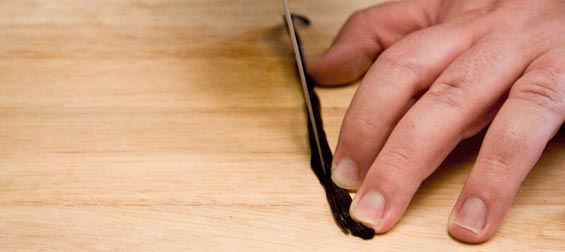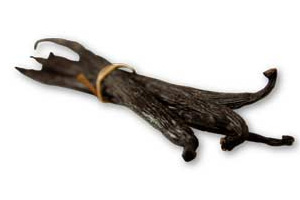How To Use Vanilla Beans
In modern vernacular, the word vanilla means unexciting, conventional, or boring, but none of those adjectives apply to the vanilla bean. Real vanilla beans are a fantastic ingredient, particularly for baking. They bring tremendous flavor to all sorts of desserts, from custards and mousses to ice cream & cakes. Some chefs even use vanilla beans in savory applications as well. Try pairing vanilla with foods like lobster, veal and foie gras.
The primary flavor in a vanilla bean comes from the tiny seeds inside each pod, though the pods have plenty of flavor too, as we’ll go into below. Vanilla bean seeds offer a more subtle, complex flavor than extract, and are great for custards, ice creams, mousses, panna cotta, tart fillings, and for making simple syrups that can be used to flavor cakes, cocktails & drinks or sorbets. People who love vanilla are always excited to see those telltale little specks in desserts, and vanilla seeds won’t tint a light-colored dessert the way vanilla extract can.
Desserts made with real vanilla beans will develop more complex flavor over time, so vanilla ice cream bases are best “aged” in the fridge for at least a few hours or ideally overnight; vanilla flavored custards will be even better the next day.
Fresh vanilla beans are costly. You may not need a whole vanilla bean in every recipe. To use part of a bean, simply use kitchen shears to snip the bean into halves or quarters, then split & scrape these pieces using the method below. Store any leftover pieces with your other beans, but be sure to use them soon, as they will likely dry out faster. And remember, don’t discard thpse empty pods. Homemade vanilla extract & vanilla sugar make great gifts!
Extracting The Seeds
1

2
Take each vanilla bean half, turn it so the shiny inside is facing up, and scrape out the tiny vanilla seeds. Add the seeds to your recipe and reserved the vanilla pod for other uses.

Note: In recipes where liquid is warmed, such as custard or hot chocolate, you can add the pod halves to the liquid along with the seeds during the heating process but remember to extract the pods later. Flavor from the pod will be steeped into the liquid along with the remaining vanilla seeds clinging to the inside of the pods.
Using the Leftover Pods
1
Make homemade vanilla extract or vanilla vodka: Steep leftover pods in alcohol to make vanilla extract at home (see our homemade vanilla extract recipe), though you will probably want to throw in some fresh vanilla beans as well. If you pull the pods from the alcohol before the mixture has reached extract strength, you’ll be left with vanilla vodka which is perfect for mixed drinks.
2
Make vanilla sugar or salt: Making vanilla scented sugar at home is extremely easy, and another good way to make use of your leftover pods. Though often called simply “vanilla sugar” by home chefs, this sugar’s flavor & scent are much milder than the vanilla sugar often used by professional chefs, which is mixed with lots of ground vanilla beans. If you want to make stronger vanilla flavored sugar by actually grinding up your beans, you’ll find instructions here: Flavored Sugar Recipes.
3
As a rule of thumb, baking guru Dorie Greenspan says use vanilla sugar or salt in place of the regular version in any recipe. Make vanilla-flavored salt by placing spent pods in a jar filled with kosher salt for a few weeks, giving it a shake every few days. Try using vanilla salt with savory foods like carrots, sweet potatoes, lobster, shrimp, or langoustines.
4
Poached fruit: Skewer pears, apples, or stone fruits with fresh or dried pods when poaching.
5
Flavor coffee or tea: Use spent pods as stirrers, steep them with tea, or grind them right along with your coffee beans.



Comments 2
Great…now I want a vanilla custard 🙂
Hard to believe, but I’ve never actually used fresh vanilla.
Pingback: Heavenly Vanilla Bean Ice Cream — That Susan Williams